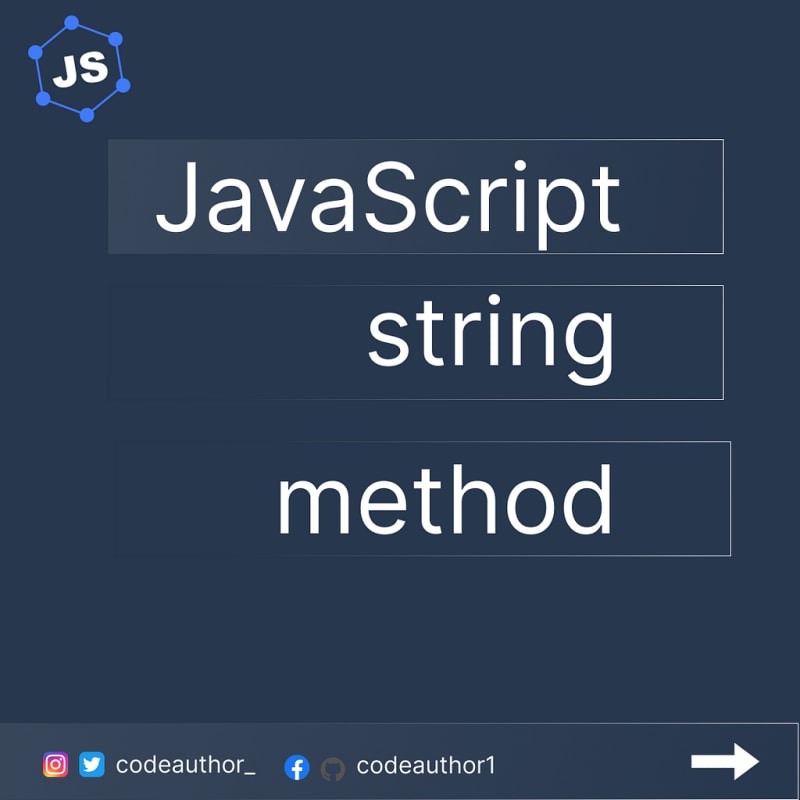
source: instagram | codeauthor_
Welcome to my blog post where we’ll dive into the world of JavaScript string methods. Strings play a crucial role in JavaScript, and having a strong grasp of the available string manipulation techniques is essential for any developer. In this comprehensive guide, we will explore 20 powerful JavaScript string methods that will empower you to handle strings with ease and efficiency. Get ready to unlock the full potential of JavaScript string methods and take your coding skills to the next level!
- String Length (length):
The
lengthproperty allows you to determine the number of characters in a string. Here’s an example:
const message = "Hello, world!";
console.log(message.length); // Output: 13
- Concatenation (concat):
The
concat()method combines two or more strings, creating a new string. Here’s an example:
const str1 = "Hello";
const str2 = "World";
const concatenatedStr = str1.concat(", ", str2);
console.log(concatenatedStr); // Output: Hello, World
- Extracting Substrings (substring):
The
substring()method extracts a portion of a string based on specified start and end indexes. Here’s an example:
const sentence = "JavaScript is amazing!";
const extractedStr = sentence.substring(0, 10);
console.log(extractedStr); // Output: JavaScript
- Searching for Substrings (indexOf):
The
indexOf()method locates the first occurrence of a specified substring within a string. Here’s an example:
const sentence = "JavaScript is amazing!";
const index = sentence.indexOf("is");
console.log(index); // Output: 11
- Replacing Substrings (replace):
The
replace()method substitutes specific substrings within a string with new values. Here’s an example:
const sentence = "JavaScript is amazing!";
const newSentence = sentence.replace("amazing", "incredible");
console.log(newSentence); // Output: JavaScript is incredible!
- Converting to Uppercase (toUpperCase):
The
toUpperCase()method transforms all characters in a string to uppercase. Here’s an example:
const message = "Hello, world!";
const uppercaseMsg = message.toUpperCase();
console.log(uppercaseMsg); // Output: HELLO, WORLD!
- Converting to Lowercase (toLowerCase):
The
toLowerCase()method converts all characters in a string to lowercase. Here’s an example:
const message = "Hello, world!";
const lowercaseMsg = message.toLowerCase();
console.log(lowercaseMsg); // Output: hello, world!
- Checking the Start of a String (startsWith):
The
startsWith()method verifies if a string starts with a particular substring. Here’s an example:
const sentence = "JavaScript is amazing!";
console.log(sentence.startsWith("JavaScript")); // Output: true
- Checking the End of a String (endsWith):
The
endsWith()method checks if a string ends with a specified substring. Here’s an example:
const sentence = "JavaScript is amazing!";
console.log(sentence.endsWith("amazing!")); // Output: true
- Trimming Whitespace (trim):
The
trim()method removes whitespace from the beginning and end of a string. Here’s an example:
const message = " Hello, world! ";
const trimmedMsg = message.trim();
console.log(trimmedMsg); // Output: Hello, world!
- Splitting a String (split):
The
split()method divides a string into an array of
substrings based on a specified separator. Here’s an example:
const sentence = "JavaScript is amazing!";
const words = sentence.split(" ");
console.log(words); // Output: ["JavaScript", "is", "amazing!"]
- Extracting Characters (charAt):
The
charAt()method retrieves the character at a specific index within a string. Here’s an example:
const word = "Hello";
console.log(word.charAt(1)); // Output: e
- Extracting Unicode Values (charCodeAt):
The
charCodeAt()method returns the Unicode value of a character at a specified index. Here’s an example:
const word = "Hello";
console.log(word.charCodeAt(0)); // Output: 72
- Checking if a String Contains a Substring (includes):
The
includes()method checks if a string contains a specific substring. Here’s an example:
const sentence = "JavaScript is amazing!";
console.log(sentence.includes("is")); // Output: true
- Checking if a String Matches a Pattern (match):
The
match()method, used with regular expressions, determines if a string matches a particular pattern. Here’s an example:
const sentence = "JavaScript is amazing!";
const pattern = /is/;
console.log(sentence.match(pattern)); // Output: ["is"]
- Repeating a String (repeat):
The
repeat()method repeats a string a specified number of times. Here’s an example:
const word = "Hello";
console.log(word.repeat(3)); // Output: HelloHelloHello
- Extracting the Last Index of a Substring (lastIndexOf):
The
lastIndexOf()method finds the last occurrence of a substring within a string. Here’s an example:
const sentence = "JavaScript is amazing!";
console.log(sentence.lastIndexOf("a")); // Output: 15
- Extracting a Subset of Characters (slice):
The
slice()method extracts a portion of a string based on specified start and end indexes. Here’s an example:
const word = "Hello";
const subset = word.slice(1, 4);
console.log(subset); // Output: ell
- Checking if a String is Empty (isEmpty):
The
isEmpty()method checks if a string is empty. Here’s an example:
function isEmpty(str) {
return str === "";
}
console.log(isEmpty("")); // Output: true
console.log(isEmpty("Hello")); // Output: false
- Checking if a String is a Number (isNaN):
The
isNaN()method determines if a string represents a valid number. Here’s an example:
console.log(isNaN("123")); // Output: false
console.log(isNaN("Hello")); // Output: true
Congratulations on learning about these 20 essential JavaScript string methods! With these techniques in your arsenal, you are now equipped to handle string manipulation tasks efficiently. Experiment with these methods, explore their variations, and apply them to solve real-world programming challenges. String manipulation is a fundamental aspect of JavaScript development, and by mastering these methods, you’ll enhance your coding skills and become a more proficient JavaScript developer. Happy coding!
Thank you, dear reader, for investing your time in reading my article. We sincerely appreciate your engagement and interest in the topic. Your support means the world to me!
We would love to hear your thoughts and feedback on the article. Did it provide you with valuable insights? Were there any specific sections that resonated with you? We value your perspective and would be thrilled to receive your comments. Also, don’t forget to give the article a well-deserved round of applause if you found it informative and helpful. Your feedback and applause inspire us to continue creating meaningful content that meets your needs. Thank you once again for being a part of our community, and we look forward to hearing from you!






Top comments (0)